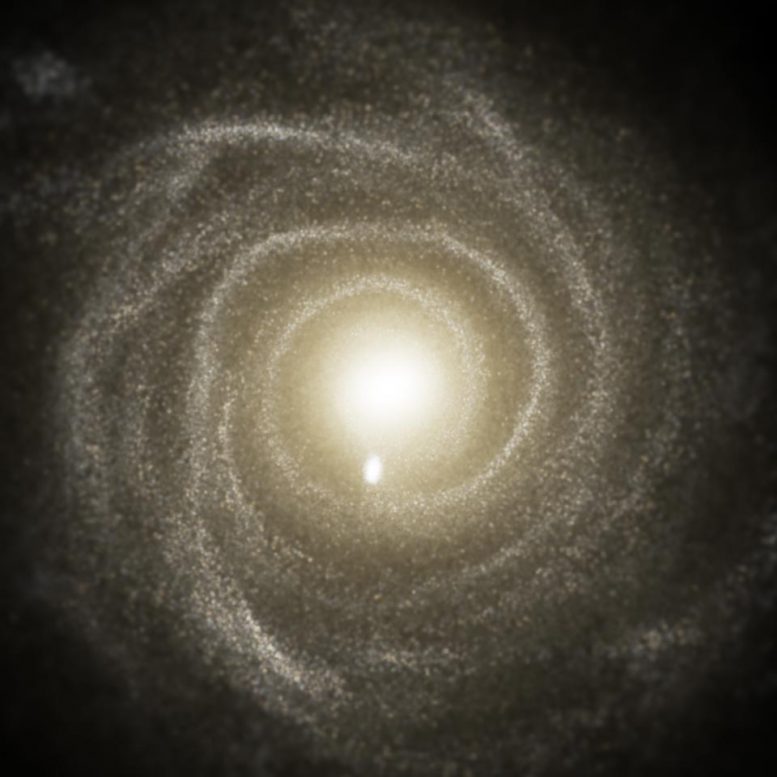
Image of the optical light emitted by the stars of a spiral galaxy from the TNG50 simulation. Credit: D. Nelson (MPA) and the IllustrisTNG team
Scientists from Germany and the United States have unveiled the results of a newly-completed, state of the art simulation of the evolution of galaxies. TNG50 is the most detailed large-scale cosmological simulation yet. It allows researchers to study in detail how galaxies form, and how they have evolved since shortly after the Big Bang. For the first time, it reveals that the geometry of the cosmic gas flows around galaxies determines galaxies’ structures, and vice versa. The researchers publish their results in two papers in the journal Monthly Notices of the Royal Astronomical Society.
Astronomers running cosmological simulations face a fundamental trade-off: with finite computing power, typical simulations so far have been either very detailed or have spanned a large volume of virtual space, but have so far not been able to do both. Detailed simulations with limited volumes can model no more than a few galaxies, making statistical deductions difficult. Large-volume simulations, in turn, typically lack the details necessary to reproduce many of the small-scale properties we observe in our own Universe, reducing their predictive power.
The formation of a single massive galaxy through time, from early cosmic epochs until the present day, in the TNG50 cosmic simulation. The main panel shows the density of the cosmic gas (high in white, low in black). Insets show large-scale dark matter and then gas (lower left), and small-scale stellar and gaseous distributions (lower right). This TNG50 galaxy will be similar in mass and shape to Andromeda (M31) by the time the movie reaches the current epoch. Its progenitor experiences rapid star formation in a turbulent gas reservoir which settles into an ordered disc after a couple of billion years of cosmic evolution. A rather quiet late-time assembly history without major mergers allows the galaxy to relax into an equilibrium balance of gas outflows from supernova explosions and gas accretion from its surroundings. Credit: D. Nelson (MPA) and the IllustrisTNG team
The TNG50 simulation, which has just been published, manages to avoid this trade-off. For the first time, it combines the idea of a large-scale cosmological simulation – a Universe in a box – with the computational resolution of “zoom” simulations, at a level of detail that had previously only been possible for studies of individual galaxies.
In a simulated cube of space that is more than 230 million light-years across, TNG50 can discern physical phenomena that occur on scales one million times smaller, tracing the simultaneous evolution of thousands of galaxies over 13.8 billion years of cosmic history. It does so with more than 20 billion particles representing dark (invisible) matter, stars, cosmic gas, magnetic fields, and supermassive black holes. The calculation itself required 16,000 cores on the Hazel Hen supercomputer in Stuttgart, working together, 24/7, for more than a year – the equivalent of fifteen thousand years on a single processor, making it one of the most demanding astrophysical computations to date.
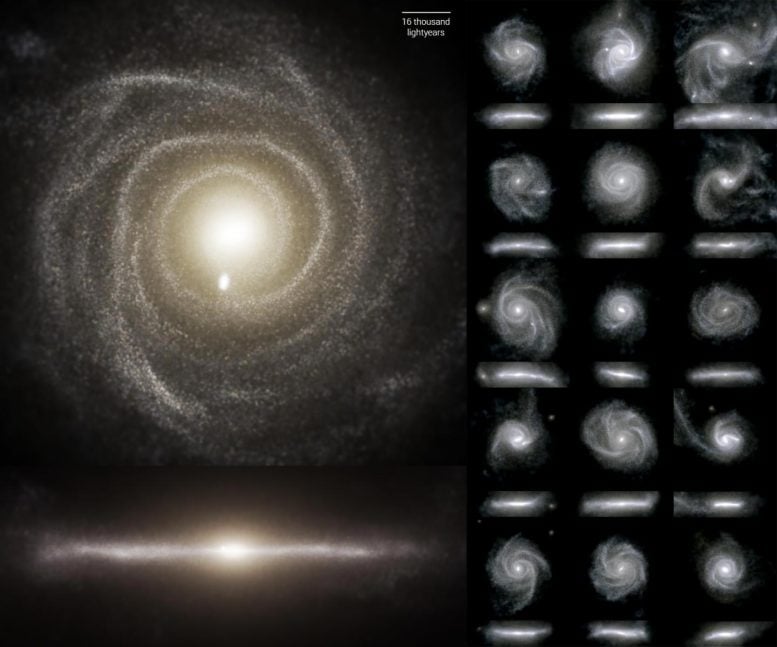
Images of the optical light emitted by the stars of 16 galaxies from the TNG50 simulation. Each galaxy is seen face-on or from the top (top sub-panels), and edge-on or from the side (lower sub-panels). Credit: D. Nelson (MPA) and the IllustrisTNG team
The first scientific results from TNG50 are published by a team led by Dr. Annalisa Pillepich (Max Planck Institute for Astronomy, Heidelberg) and Dr. Dylan Nelson (Max Planck Institute for Astrophysics, Garching) and reveal unforeseen physical phenomena. According to Nelson: “Numerical experiments of this kind are particularly successful when you get out more than you put in. In our simulation, we see phenomena that had not been programmed explicitly into the simulation code. These phenomena emerge in a natural fashion, from the complex interplay of the basic physical ingredients of our model universe.”
TNG50 features two prominent examples of this kind of emergent behavior. The first concerns the formation of “disc” galaxies like our own Milky Way. Using the simulation as a time machine to rewind the evolution of cosmic structure, researchers have seen how the well-ordered, rapidly rotating disc galaxies (which are common in our nearby Universe) emerge from chaotic, disorganized, and highly turbulent clouds of gas at earlier epochs.
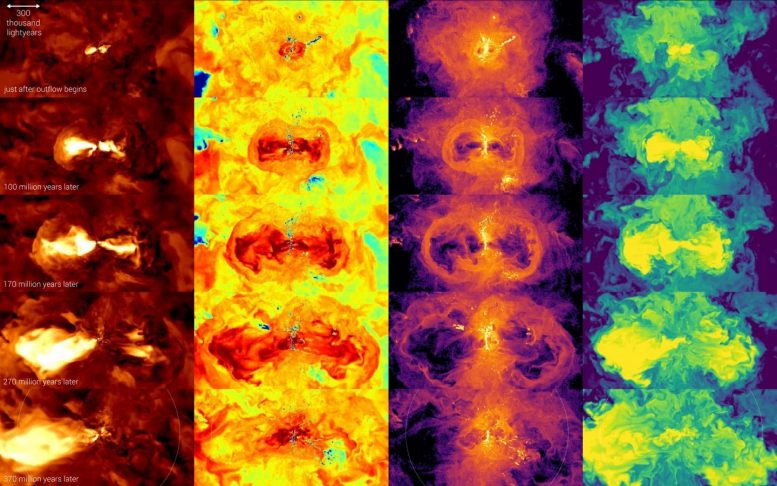
Evolution over a few hundred of million years (from top to bottom) of the gas around a galaxy from the TNG50 simulation, with an active super massive black hole at its center. The black hole at the center of this galaxy is consuming gas from its surroundings and in doing so is generating copious amounts of energy. The release of this energy produces ultra-fast winds, which rapidly expand away from the galaxy and grow in size to become thousands of times larger than they started. These black hole driven outflows achieve velocities of tens of thousands of kilometers per second, have temperatures exceeding millions of degrees, and carry with them copious amounts of heavy elements such as oxygen, carbon, and iron. The four columns show, from left to right, the evolving velocity, temperature, density, and heavy element content around the galaxy. The galaxy itself is a cold (blue, second column), dense (yellow, third column) disc of star-forming gas visible as a small, vertical slab in the very center of each image. Credit: D. Nelson (MPA) and the IllustrisTNG team
As the gas settles down, newborn stars are typically found on more and more circular orbits, eventually forming large spiral galaxies – galactic carousels. Annalisa Pillepich explains: “In practice, TNG50 shows that our own Milky Way galaxy with its thin disc is at the height of galaxy fashion: over the past 10 billion years, at least those galaxies that are still forming new stars have become more and more disc-like, and their chaotic internal motions have decreased considerably. The Universe was much messier when it was just a few billion years old!”
As these galaxies flatten out, researchers found another emergent phenomenon, involving the high-speed outflows and winds of gas flowing out of galaxies. This launched as a result of the explosions of massive stars (supernovae) and activity from supermassive black holes found at the heart of galaxies. Galactic gaseous outflows are initially also chaotic and flow away in all directions, but over time, they begin to become more focused along a path of least resistance.
In the late universe, flows out of galaxies take the form of two cones, emerging in opposite directions – like two ice cream cones placed tip to tip, with the galaxy swirling at the center. These flows of material slow down as they attempt to leave the gravitational well of the galaxy’s halo of invisible – or dark – matter, and can eventually stall and fall back, forming a galactic fountain of recycled gas. This process redistributes gas from the center of a galaxy to its outskirts, further accelerating the transformation of the galaxy itself into a thin disc: galactic structure shapes galactic fountains, and vice versa.
The team of scientists creating TNG50 (based at Max-Planck-Institutes in Garching and Heidelberg, Harvard University, MIT, and the Center for Computational Astrophysics (CCA)) will eventually release all simulation data to the astronomy community at large, as well as to the public. This will allow astronomers all over the world to make their own discoveries in the TNG50 universe – and possibly find additional examples of emergent cosmic phenomena, of order emerging from chaos.
Reference: “First results from the TNG50 simulation: galactic outflows driven by supernovae and black hole feedback” by Dylan Nelson, Annalisa Pillepich, Volker Springel, Rüdiger Pakmor, Rainer Weinberger, Shy Genel, Paul Torrey, Mark Vogelsberger, Federico Marinacci and Lars Hernquist, 29 August 2019, Monthly Notices of the Royal Astronomical Society.
DOI: 10.1093/mnras/stz2306

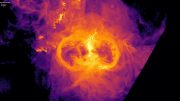

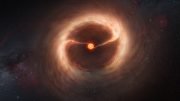

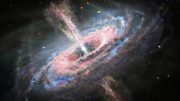
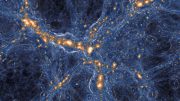
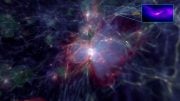
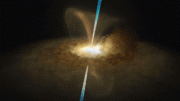
Video game astronomy, cool!
Simulations are only as good as the countless assumptions used to create them, and the fudge factors based on bias, at least in this case, are literally galactic in proportion. The bigger the variables, the less useful the simulation because more and more decisions have to be made as at to what to load into the simulation. And in this case, it’s pretty much all assumption.
Basically what’s been done is that you assume the results you’re seeking to verify, use them to develop your simulation, and with the help of countless manipulated variables show that your assumptions are correct. Simulations are invariably grandiose exercises in circular logic.
BTW, simulating that something can happen does not in any way indicate that it did happen. You can convincingly simulate just about anything. Even taking a simple simulation, let’s say of a hiker who died of dehydration. You know when they started out and where, and where they were found 7 days later, and you’re going to simulate what route they took and when exactly they died. You can create a very convincing simulation based on assuming average hiking speed, average consumption of water, type of terrain, etc, and a very logical simulation could be developed showing what supposedly happened. But countless variables, or just one variable, could easily disqualify that simulation, like the amount of water the hiker started off with, temperature, clothing, accidents, amount of weight they were carrying, health and fitness, other unanticipated possible routes, how long and far they hiked any given day, etc etc.
Once a simulation is put into play though, it is often given way more credibility than it should. That is why, according to the American Bar Association, it is considered that “simulation evidence can be a distraction to jurors, can carry more influence than it should, and can distort the facts of a case.” Don’t see this cautionary consideration being applied to astrophysics, quite the opposite in fact.
Chandaryaan2 3D images https://www.sarthtya.tech/2019/11/chandaryaan2-chandaryaan2-send-their.html?m=1
Well that Spiral Galaxy looked round to me. “Simulations are invariably grandiose exercises in circular logic.”